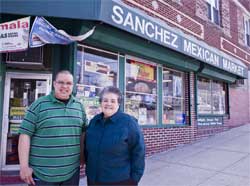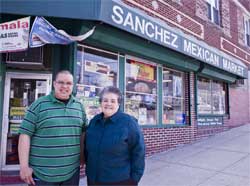 Landscape has changed for Hispanics in last decade
Landscape has changed for Hispanics in last decade
KINGSTON, R.I. – May 16, 2011 – When Rosa Maria Pegueros first moved to Rhode Island from Los Angeles 18 year ago, life in her new surroundings was far different than it is today.
When she first arrived at the University of Rhode Island, the history and women’s studies professor saw her classes filled with mostly white students mixed with a few black students. Hispanic students were few and far between, and the Latino student organizations on campus were only just beginning to form.
According to University data for the fall 2010 semester, the Hispanic student population at URI now accounts for nearly 6 percent of the overall student population, making it the highest percentage among minority students. This mirrors a trend that has seen the Latino population in Rhode Island grow by 43.9 percent in the last decade. Hispanics now make up 12.4 percent of the state’s population.
“The influx of Hispanics to Rhode Island seemed slow and steady when I came in 1993 through 2000,” said Pegueros, who lives in Providence. “Then it picked up. I began to notice the busboys in restaurants were Central American.”
Eventually she noticed more and more of the cooks hailed from Central America.
“On Brook Street near Brown University, there is a bagel place,” Pegueros said. “The guys who run the shop are all Latin. They have a funny mix, because they sell Latin food and bagels (which associated with Jewish culture).”
Over time, more and more businesses took on a Hispanic feel. When she arrived in the state, there were few places like the Sanchez Mexican Market, a spot that helped her feel connected to her Latino culture. Her mother is from El Salvador, and her father was Mexican-American, born in San Francisco.
“Now I can go to Atwells Avenue for the Mexican delicatessen, and it makes life more comfortable,” Pegueros said.
The changes have had significant impact in the political landscape as well. During the last decade, Rhode Island’s overall population only grew by 0.4 percent, despite the influx of Hispanics. Without the growth of the Latin population, Rhode Island would have lost one of its two seats in the U.S. House of Representatives.
In January, Angel Taveras made history when he was sworn in as the first Hispanic mayor in Providence’s history.
“His election was encouraging, but even more surprising than his election was his nomination in the first place,” Pegueros said. “When he won the Democratic nomination, it was certain he would win the mayoral race. He did a tremendous amount of legwork. He personally came to my door.”
Pegueros said Taveras was an example of how Hispanics can succeed in the country. The son of immigrants from the Dominican Republic, Taveras graduated from Harvard University before going to law school at Georgetown University.
“He’s not a yahoo. He is a very smart guy and the city believed in him,” Pegueros said.
Still, she wasn’t sure how the voters would respond when Taveras said he felt drastic measures would need to be taken in the Providence school system to address the city’s budget crisis. In February, Taveras announced the firing of 1,900 city teachers, though the actual number was reduced to 119 this month.
“Rhode Island is a union state. I believe in collective bargaining,” Pegueros said. “But he was up front and said, ‘This is affecting me. I came out of public schools as a student. We have a hurricane 5 level disaster.’ He was honest about, and maybe it made people realize he didn’t have a choice.
“I feel there is a real confidence in his leadership,” Pegueros said. “It’s not just that he won, but he won by such a majority. That speaks to the acceptance of him, and of minority leadership in general.”
Pictured above
Professor Rosa Maria Pegueros has seen the Hispanic population change both
the cultural and political landscape in Rhode Island during the last decade.
Photo by Michael Salerno.

